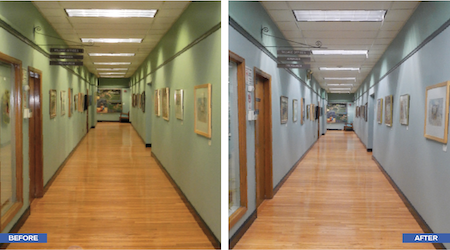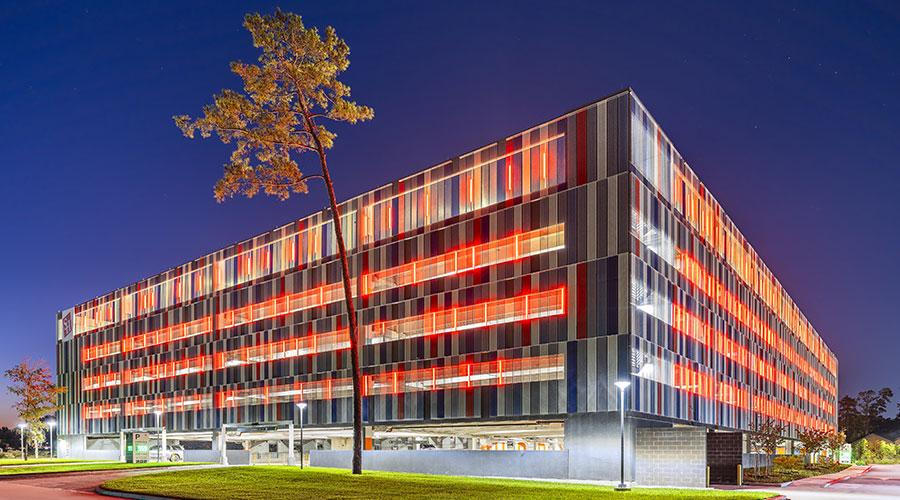 Before and after photos show how wall color appears to change from medium green to medium blue after a TLED retrofit, even though the existing fluorescents and the new LEDs had essentially the same CCT and were both 80 CRI.
Before and after photos show how wall color appears to change from medium green to medium blue after a TLED retrofit, even though the existing fluorescents and the new LEDs had essentially the same CCT and were both 80 CRI.5 Tips for Selecting LEDs
LEDs are an easy win for energy savings. But make sure you select the right type for your space. Here's what you need to know.
For facility executives seeking a high ROI option to cut energy bills and carbon footprints, deploying LED (light emitting diode) lighting technology would be hard to beat. Depending on prevailing electric rates and local incentives, payback periods under three years are becoming common. But this new technology comes with a few caveats. Issues regarding savings claims, lighting quality and distribution, controls, and flicker need attention before signing a big purchase order.
Dozens of options are now available for upgrading fluorescent fixtures with either one-for-one tubular LED (TLED) lamps or retrofit kits that give old fixtures a new look. LED technical advances and competitive pricing are rapidly pulling market share from the now-dated T12 and T8 fluorescent lamp offerings, with LEDs now accounting for about 30 percent of linear fluorescent/LED shipments. Toss in no relamping for over a decade, an end to lamp recycling (LEDs contain no mercury), optional built-in emergency battery backup, and elimination of ballasts, and the pot gets even sweeter. For facility managers with a few extra bucks to spend on new LED fixtures, consider also motion sensing dimming, circadian color adjustment, and a stunning array of luminaire shapes that could have come from Buck Rogers’ office.
As with any new product, there were some bumps along the retrofit road: A few years ago, thousands of TLEDs had to be recalled when their faulty circuit boards emitted smoke. Fortunately, those days are now behind this technology. However, reality still needs to be separated from hype.
1. Be realistic with savings expectations
While in some cases wattage reductions of 70 percent are possible, how far you go depends on your starting point.
When replacing incandescent lamps in screw-in fixtures, 85 percent savings may be possible, but 35 percent to 50 percent is more likely if the LEDs are replacing compact fluorescents.
If replacing electronically ballasted T8 fluorescent lamps (the efficient standard back in the ‘90s), on a one-for-one basis, 50 percent to 55 percent savings are common while maintaining light levels.
In enclosed fixtures (e.g., lensed troffers) heat from the lamps and ballasts “cooks” T8 lamps, cutting their light output, but TLED output is unaffected by heat. In such cases, a clever retrofitter may replace 4 fluorescents with 2 high output TLEDs, cutting wattage by about 65 percent while maintaining light levels. Even greater savings may occur if you’re starting with magnetically ballasted T12 lamps in an enclosed fixture.
TLEDs are also available to replace electronically-ballasted T5 lamps (the high efficiency option of the early ‘00s). In a side-by-side test with wall-mounted indirect fixtures in an office, 24-watt T5HO TLEDs successfully replaced fluorescent 54-watt T5HOs, cutting wattage by 56 percent while boosting light levels by 15 percent. Payback was roughly one year, not including the labor to switch out the lamps.
In a direct-indirect fixture, however, light output dropped by 15 percent because (as described below) the TLED’s light distribution was sub-optimal for that design.
When installing new fixtures designed to work with LEDs, a driver is used instead of a ballast, optics and distribution are optimized for LEDs, etc. Savings of 60 to 65 percent are common relative to the T8 fixtures they typically replace, with higher savings when replacing ‘60s vintage T12 fixtures.
2. Spreading the light around
When a room’s lighting is properly designed, fixtures are spaced to ensure consistent task light levels below and between fixtures. Tubular fluorescent lamps emit light equally around their circumference and depend on reflective surfaces in fixtures to evenly distribute their light. Some LED retrofits may, however, narrow that distribution, yielding inconsistent light levels, occupant discomfort, etc., that may negate the dollar savings from reduced wattage.
To avoid this problem, check the TLED’s spec sheet for its beam angle, i.e., the included angle below a horizontal lamp wherein beam intensity is 50 percent or more of its maximum candela intensity. Look for beam angles exceeding 200 degrees across their long axis (some TLEDs have beam angles exceeding 300 degrees).
Note, however, that some vendor beam angle data has not been accurate. The best way to assure acceptable light distribution is through a test using sample LED units installed in fixtures of the type you plan to retrofit. Before making any changes, take horizontal and vertical surface light levels at several room locations. Write those numbers on Post-It notes placed at those points. After the retrofit work is done, write the new levels at those points on the same notes. If most are within 15 percent to 20 percent of the original, few people will notice the change. If they are much different, or if walls are darkened or glare occurs, consider choosing better LED units.
In some cases, merely painting walls a lighter or darker color (thus altering their reflectance) may be sufficient to ameliorate the problem. To better distribute their light, some retrofit kits have shaped lenses that widen and soften distribution. Either option may make a space look and feel brighter without impacting task light levels.
3. Color me correctly
Just as fluorescent lamp colors may be chosen based on their correlated color temperature (CCT) — e.g., 2700K or 4100K — TLEDs and kits are available in similar color options, e.g., 3000K or 4000K. As of early 2019, none are available that can change their color. Some new LED fixtures, however, are (with appropriate controls) able to do so. The added value of such capability is tied closely to their end use (e.g., hospitals, nursing homes, showrooms).
The color rendering index (CRI) score indicates how closely color is matched (on a scale of 0 to 100) to an ideal light source. Most T8 and T5 fluorescents have CRI of 80 or higher, making them acceptable for many uses. Similar CRIs are claimed by many TLED and kit vendors, but side-by-side comparisons with fluorescents found noticeable differences. While their LEDs mimic color from good quality fluorescents, they may emit less red. Color standards are based on 14 test sample colors, but only the first eight may be used in verifying commercial lamp CRI. The ninth is a rich red that (to varying degrees) appears in fluorescents, but not in retrofit LEDs — There is no industry standard requiring it. LED fixtures may be specified with LEDs having CRIs as high as 98, but the same is not yet true with retrofit options.
When all fluorescent lamps in the same room are replaced with TLEDs, few occupants (unless they are artists) may notice the difference. The before and after photos above show how wall color appears to change after a TLED retrofit: Existing fluorescents were 4100K and 80 CRI while the TLEDs were 4000K (essentially the same CCT) and 80 CRI. Medium green under fluorescent lighting shifted to medium blue under LEDs, and some wall paintings looked a bit different, but nobody complained. If, however, half the lights had remained fluorescent, the difference would have been obvious.
Bottom line: Where color quality is crucial (e.g., to enhance appearance of products, furnishings, or people), facility managers may wish to specify and budget new fixtures containing high quality LEDs.
4. Take control of your control options
Are any fixtures to be retrofitted presently controlled by dimmers? Most TLEDs and kits cannot be dimmed on standard dimmer switches. Trying to do so may damage either the lamps or the dimmers; it may also cause lamps to visibly flicker. Vendor specs for dimmable LED devices (or new fixtures) should list the types of dimmers with which they are compatible. Even if listed, try dimming several sample units on an existing dimmer. Note if the dimming is linear, e.g., a 30 percent movement on a slide dimmer yields a roughly comparable drop in foot-candles. Watch for where dimming stops on the slider: Some dimmable TLEDs stop dimming part way down, with no additional dimming thereafter. Look for visible flicker at any setting.
Some lighting practitioners push for installation of occupancy sensors as part of an LED retrofit. Unlike fluorescent lamps whose lives may be shortened by the frequent cycling of sensors, LED lifetimes are not affected by it, making LEDs ideal companions to sensors. Where sensors already exist, their cycle time (i.e., how long lights remain on after the last sensed motion) may then be shortened to only a few minutes, increasing savings at no cost beyond the personnel time to adjust the sensors.
But if no sensors exist, the drop in wattage from switching to LEDs may double sensor payback period (i.e., cut its ROI in half). The number of needed sensors is generally proportional to room size, which won’t change when lighting wattage drops. Depending on the structure of a facility’s electric rate (e.g., proportion that is based on peak demand versus consumption), sensors may not make economic sense once lighting wattage is significantly reduced. However, the addition of occupancy sensors may be required by a building or energy code when changing lighting systems. While some codes do not apply due to simple relamping (e.g., replacing a T8 with a TLED), others may apply when replacing fluorescent fixtures with those having built-in LEDs.
5. Flicker is not your friend
A 2018 comparison of 10 different LED retrofit options surprised lighting practitioners when it found that some emitted non-visible flicker. Decades ago, before electronic ballasts became the norm, fluorescent lamps in the United States emitted non-visible flicker at 120 Hz due to the alternating current delivered from the local utility. Magnetic ballasts essentially passed that oscillation to the lamps, causing the flicker. For most people, it was not visible and not a problem, but for some it caused headaches, fatigue, or worse. About 1 in 4,000 people have a degree of photosensitive epilepsy that makes them sensitive to non-visible flicker. Some children with autism spectrum disorder may exhibit hyperactivity or behavioral problems from it. Electronic ballasts eliminated the problem: They cause lamps to flicker at 40,000 Hz, far beyond human sensibility.
The comparison test found that three of the 10 LED retrofit options emitted 120 Hz flicker with intensities comparable to those from magnetically-ballasted fluorescents. At present, there is no regulation or standard requiring LED units to limit their non-visible flicker.
To understand this issue, let’s review the 3 types of TLEDs, as defined by Underwriter Laboratories:
• Type A are powered by existing electronic ballasts, so there was no issue.
• Type B are wired around the existing ballast, sending line voltage power to the TLEDs. Unless they have built-in filters, some may flicker at low frequencies.
• Type C (and all retrofit kits) use drivers separate from their LEDs. Some drivers may lack current filters, causing their lamps to flicker at low frequencies.
In the comparison test, two of the type B TLEDs and one type of retrofit kit exhibited excessive 120 Hz flicker. To their credit, two of the vendors that were alerted to the issue then changed their products to eliminate it.
TLEDs and retrofit kits are still so new to the market that this issue has not yet emerged as a problem. To avoid it, lighting specifiers may require that units to be purchased (TLEDs, kits, or new fixtures) comply with IEEE Standard 1789-2015, “Recommended Practice 1 for Low-Risk Level.” This translates to about 10 percent (or less) flicker at 120 Hz, which is below the trigger level. That standard is presently voluntary, but the lighting industry is working toward a comparable rule to eliminate products having this problem. To verify that an LED option does not emit problematic flicker, test it with a flicker wheel or ballast discriminator.
Lindsay Audin, CEM, LEED AP, CEP, is president of EnergyWiz, an energy consulting firm based in Croton, N.Y. He is a contributing editor for Building Operating Management.
Email comments and questions to edward.sullivan@tradepress.com.
Related Topics:












